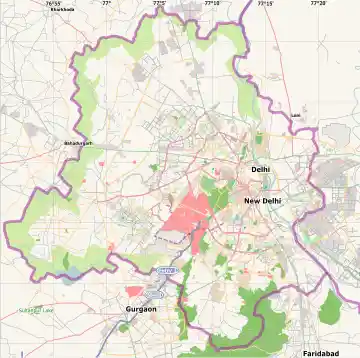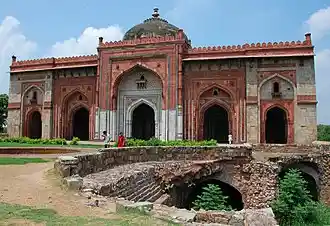THE TWO MUGHAL CITIES OF DELHI
Since this is the last part of the series of cities of Delhi, we focus on the Mughal architecture and the two emperors who gave us the cities of Purana Quila and Quila-e-Mubarak.

Purana Quila on Map. Image Courtesy: Wikimedia Commons
- The year of bidding adieu to the Delhi Sultanate when Babur defeated Ibrahim Lodhi in the Battle of Panipat. With this started a new imperial regime in the subcontinent with the Mughal Empire.
The Mughal rulers are known for their architectural commissions and construction of new capitals for more than 200 hundred years of their rule. Like many other rules, Delhi became a favorite spot for the construction of a city. Even today, we visit and explore these two cities because of their grandeur and the historical significance behind their being. The Purana Quila or Dinpanah and the Red Fort or Quila-e-Mubarak dot Delhi’s landscape even today and are a nostalgic memory of the rich cultural heritage of the Mughal empire.
Purana Quila/ Dinpanah was constructed by the second Mughal ruler- Humayun and his archnemesis Surid Sultan Sher Shah. The accounts of Abul Fazl mentioned the construction of Purana Quila by Humayun on the ancient land of Indraprastha. Humayun started the construction of his capital in 1533 but due to his rivalry with Sher Shah, he lost the war and was disposed of for a few years.
During this time of disposition, Sher Shah took upon himself to construct the half-finished capital of Humayun. He strengthened the fortification and was responsible for the construction of various structures within the citadel as well. However, there is still ongoing speculation to know how much was constructed by each of the rulers.
The Red Fort is a perfect example of the amalgamation of Persian architecture with Indian traditional structural elements. Even today, the fort is one of the favourite sports for tourists and history enthusiasts to revisit the glorious past of Delhi. The boundary walls are asymmetrical and this fortress-palace was the focal point of Shahjahanabad.
15 years later, Humayun took his Mughal Empire back from Sher Shah. However, as soon as he gained back to power, Humayun died after falling from the stairs of his library in the complex of Purana Quila.
Even today if you visit the fortified city of Humayun and Sher Shah, you can feel the depth of history seeping through the land. The city saw the change of power dynamics, while still trying to stand up on its feet and the death of its commissioner. The architectural beauty is so mesmerizing that it is difficult to take your eyes off of it. This city of Delhi was the beginning of numerous architectural marvels Mughals had to offer the Indian subcontinent.done.
After Humayun’s death, Akbar, his 13-year-old son, took over the throne and shifted his capital to Agra. He commissioned the construction of Agra Fort, the new capital of the Mughal Empire. It was not until Shah Jahan came to power that Delhi again saw the light of becoming the capital city.
On 12th May 1638, Shah Jahan decided to move back to Delhi and after having a conversation with architect Ustad Ahmad Lohri, the construction of Quila-e-Mubarak started. While Shah Jahan’s regime is believed to be the golden age in architecture, the Red Fort was the peak of this golden glory.
However, the glamour that we see today is incomplete because Nadir Shah’s invasion in 1739 plundered and looted magnificent artwork and the jewels that once glamoured the halls of Red Fort. The renowned peacock throne was one of the many things that were taken away and dismantled.
Both of these forts have a charm around them. They encompass the past glory along with the tremors of power play. They became the place of refugee and the voice of rebellion, the land of independence and the dream of freedom. These cities of Delhi are more than just the ostentatious portrayal of a king’s power. They are also the forts of human plight.

Red Fort. Image Courtesy: Wikimedia Commons

Quila Kuhna Masjid in Purana Quila. Image Courtesy: Wikimedia Commons

Mughal Emperor Shah Jahan. Image Courtesy: Wikimedia Commons


